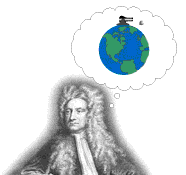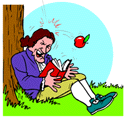

http://microgravity.nasa.gov/wimg.html
Gravity, Newton’s other great contribution, is one of the four fundamental forces in the universe, though the fundamental principles of it eluded scientists until Sir Isaac Newton was able to mathematically describe it in 1687 (Eddington, 1987). Gravity plays a serious part in everyday actions as it keeps everything on the ground; without gravity everything would be immobile unless a force was applied. The apple is one of the two curiosities (the other being the moon) that led Newton to discover the The Law of Universal Gravitation in 1666 (Keesing, 1998; Sullivat, 1998). As Newton later wrote, it was the sight of an apple falling to the ground (he was resting at Woolsthorpe because of the plague in Cambridge) that caused him to wonder if this same force was what held the moon in place (Fara, 1999; Gamow, 1962).

http://www.physik.rwth-aachen.de/group/thphys/tpe/tpe.html
Because of Galileo’s work, Newton knew that an object fell to the Earth
at a rate of about 9.8 meters (32 feet) per second. Thus “the apple [that]
fell from the tree” fell to the Earth at about this rate. For the first
basic explanation of this he assumed a linear plane, one in which all forces
act in only one direction. Therefore, when the apple fell it went straight towards
the center of the earth (accelerating at about 9.8 meters per second). Newton
surmised that the same force that pulled the apple to Earth also pulls the moon
to the Earth. But what force keeps the moon from flying into the Earth or the
Earth flying into the sun (Edwards, 1967)?

http://www.enchantedlearning.com/subjects/astronomy/planets/earth/Mass.shtml
To better understand this, one other aspect must first be understood. Galileo
showed that all objects fall to the Earth at the same rate (the classic cannonball
and feather proved this). But why? If a cannonball and a feather were both dropped
from the top of the Empire State Building in a vacuum then they would both slam
into the ground at the same rate. Newton realized that the moon and the apple
were both being pulled towards Earth at the same rate but only one who resisted
the force and stayed in its elliptical orbit (Eddington, 1987). Newton’s
Third Law of Motion says that every force exerted by one object on another is
equal to a force, but opposite in direction, exerted by the second object on
the first (every reaction has an equal but opposite reaction). So the force
of the Earth pulling the apple to the ground is proportionally the same as the
force the apple exerts back on the Earth (Newton, 1687).
Home Page | Newton's Life | Fluxions and Calculus | Law of Gravitation | Book: Principia | Bibliography